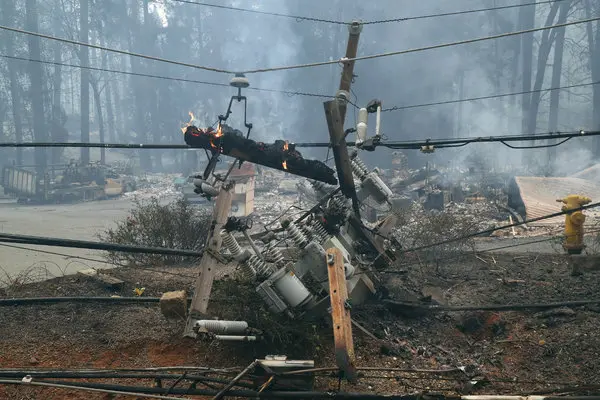California and PG&E have reached an agreement to bring the company out of bankruptcy
California authorities and Pacific Gas and Electric,
whose equipment malfunction was one of the causes of a devastating natural fire in the US state in 2018, have reached an agreement to exit the corporation from bankruptcy, the Wall Street Journal reports, citing a statement by California Governor Gavin Newsom.
PG&E management reportedly agreed to put the company up for sale if it fails to emerge from bankruptcy by June 30, the deadline set by California authorities.
In addition, PG&E also intends to use shareholder funds to reduce debt and submit to stricter oversight, which, according to the newspaper, could lead to the nationalization of the company.
“With these new tools, the state will have the legal authority to continue to demand a complete transformation, even after the company emerges from bankruptcy,” the publication says.

In November 2018, severe wildfires in California killed 86 people, destroyed about 14,000 homes, 528 commercial buildings, and more than 4,000 other structures. According to eyewitnesses, both a strong wind and a large number of dried trees and shrubs, which local authorities forbid to remove in order to preserve natural conditions, contributed to the rapid spread of fire.
The investigation found that the fires were at least partly caused by omissions by Pacific Gas and Electric. The company admitted that its equipment was to blame for the fires, which caused sparks that led to a fire. The company had to pay $11 billion to insurance companies, and it also agreed to pay $1 billion in a lawsuit from local authorities. In January, Pacific Gas and Electric filed for bankruptcy protection due to financial problems. The company said the total compensation for the 2018 and 2017 fires is over $30 billion.
PG&E and the environment
Beginning in the mid-1970s, regulatory and political developments began to push California utilities away from the traditional business model. In 1976, the California State Legislature amended the Warren-Ahlquist Act, which created and gives the California Energy Commission the legal authority to effectively prohibit the construction of new nuclear power plants. The Environmental Defense Fund (EDF) mediated in the 1978 PG&E General Rate (GRC) case, arguing that the company’s requests for higher rates were based on unrealistically high load growth forecasts. In addition, EDF said that PG&E could more economically stimulate industrial cogeneration and energy efficiency than build more power plants. As a result of EDF’s involvement in PG&E tariff cases, the company was eventually fined $50 million by the California Public Utilities Commission for failing to adequately implement energy efficiency programs.
Early in the first decade of the 21st century, PG&E Corporation CEO Peter Darby and then-Pacific Gas & Electric Company CEO Tom King publicly announced their support for California Assembly Act 32, a statewide measure to curb greenhouse gas emissions. emissions and reduce emissions by 25% by 2020. The law was signed into law by Governor Arnold Schwarzenegger on September 27, 2006.
In 2014, the share of renewable energy in PG&E was 28%. By 2016, 32.9% of PG&E’s energy sources were renewable.

The PG&E Pipeline Safety Initiative (CPSI) has essentially cut down hundreds of thousands of trees in California from Eureka to Bakersfield along their nearly 7,000 miles of gas transmission pipeline. PG&E has not conducted a CEQA assessment in any of these cities, and the total number of trees cut is known only to PG&E.
In 2017, PG&E announced that 80% of the electricity supplied by the company comes from greenhouse gas-free sources, including renewable energy, nuclear and hydropower. About 33% comes from renewable sources, which is in line with California’s goal of having 33% of its electricity from renewable sources by 2020, nearly three years into the future.
In June 2020, PG&E announced a 12-month research and development effort with Socalgas and Opus 12 to convert raw biogas to carbon neutral methane. This technology will allow the use of energy from renewable sources (such as wind and solar) to produce fuel from landfills, wastewater and dairy farms.
